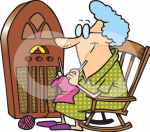3LO was the second Melbourne broadcaster, which commenced on October
13, 1924. It was owned and operated by the Australian Broadcasting Company,
which also managed 2FC and 2BL in Sydney. 3LO operated on longwave,
using 174 kHz (1720 metres). The frequency was subsequently changed to 810 kHz mediumwave
on July 2 1925.
The station leased the transmission facilities of AWA at Braybrook,
8 km west of the city, until October 1938 when it was relocated to a new PMG site at St Albans (now known as Sydenham), in
Melbourne’s northwest. At that time, the contract with AWA was terminated.
The studio and control room were in downtown Melbourne, located in the Cambridge
Building, Collins St. The program feed was via PMG landline to Braybrook.
The Sydenham station consisted of transmitter and control building, and a vertical
antenna mast 700 ft. high (250 metres) which also carried the programs of the other Melbourne station 3AR. The mast is still
in use today!
3LO on Shortwave
3LO was the first
broadcaster in Melbourne to have regular external shortwave transmissions, known as the Voice of Australia,
which started in September 1927 from the Braybrook transmitting facility. The SW station used the
callsign VK3ME.
This is a summary of significant events in the long history of 3LO Melbourne!
May 25 1924
The proposal to establish an AWA facility at
Braybrook was announced in the “Sunshine Advocate”
October 13 1924
Official commencement, as part of the Australian
Broadcasting Company. Operated on longwave, 174 kHz, 1720 metres. The transmitter, 5 kW, was at the AWA Braybrook Radio Centre,
8 km west of central Melbourne.
July 2 1925
Frequency changed from longwave to mediumwave
810 kHz
May 30 1927
New studios inaugurated, in a former factory,
off Russell St, Melbourne
September 1927
Shortwave broadcasts from 3LO, using the Braybrook
centre, commenced. These continued until 1929 when programs were then originated from AWA.
July 1 1932
The Australian Broadcasting Commission was established
and 3LO was one of the first stations to join.
September 1 1935
Frequency changed to 770 kHz
1936
Proposal to build a new facility at a location
near Deer Park, west of Melbourne, for 3LO, 3AR, and shortwave 3LR.
1937
Plans announced to build a new facility for
3LO, 3AR and VLR at a new site at St Albans (later known as Sydenham). The Deer Park proposal was abandoned).
January 1938
St Albans facility construction commenced
1938
October St Albans site officially commenced,
for 3LO and 3AR. One mast, 250 m high, using filters for separation of 3AR and 3LO transmissions.
1942
3LO and 3AR moved into new studios at the newly built Broadcasting House in Lonsdale
St.
1975 Frequency changed to 770 kHz, as part of the 9 kHz channel separation process
1995
All Melbourne-based radio and TV ABC operations were transferred to a newly built
building at Southbank

